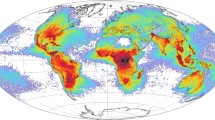Abstract
Ground-based microwave spectroscopy is a powerful technique for remote sensing of minor constituents, such as H2O, in the middle atmosphere that might otherwise be difficult to measure quantitatively. The 616–523 H2O transition at 22.2 GHz is particularly well suited for this application. It is optically thin and at a low frequency which allows straightforward inversion of spectra to recover altitude profiles up to ∼80 km altitude. Because of considerable radioastronomical interest in this transition, which is non-thermally excited in the interstellar medium, many suitable receiver systems are available1–3. Monitoring of the H2O altitude profile on short and long time scales is practical and has been going on from Haystack Observatory for several years2,4,5. The principal limitation of this experiment is not receiver sensitivity—a few hours of integration are sufficient to produce an H2O atmospheric emission spectrum suitable for inversion—but, rather, baseline curvature in the receiver–spectrometer system. Baseline effects have limited the effective bandwidth of the Haystack experiments to 6.67 MHz making the effective lower altitude limit of profile inversion ∼50 km. They are also a dominant source of error in recovered profiles in the 50–60 km range. We present here the first results of observations with a new receiver system developed specifically to observe atmospheric H2O which allowed a spectrometer bandwidth of 40 MHz to be used and, thus, allowed the H2O profile from ∼35 to 80 km to be recovered. The resulting profile, although only a ‘snapshot’ of a probably time-dependent phenomenon, is consistent with previous measurements in the mesosphere and stratosphere.
This is a preview of subscription content, access via your institution
Access options
Subscribe to this journal
Receive 51 print issues and online access
$199.00 per year
only $3.90 per issue
Buy this article
- Purchase on Springer Link
- Instant access to full article PDF
Prices may be subject to local taxes which are calculated during checkout
Similar content being viewed by others
References
Radford, H. E. et al. J. geophys. Res. 82, 472 (1977).
Thacker, D. L., Gibbins, C. J., Schwartz, P. R. & Bevilacqua, R. M. Geophys. Res. Lett. 8, 1059 (1981).
Deguchi, S. & Muhleman, D. C. J. geophys. Res. 87, 1343 (1982).
Gibbins, C. J., Schwartz, P. R., Thacker, D. L. & Bevilacqua, R. M. Geoophys. Res. Lett. 9, 131 (1982).
Bevilacqua, R. M. et al. J. geophys. Res. (submitted).
Russell, J. M. III et al. J. geophys Res. (submitted).
Hudson, R. D. & Reed, E. I. The Stratosphere: Present and Future (NASA Ref. Publ., 1049, 1979).
Author information
Authors and Affiliations
Rights and permissions
About this article
Cite this article
Schwartz, P., Croskey, C., Bevilacqua, R. et al. Microwave spectroscopy of H2O in the stratosphere and mesosphere. Nature 305, 294–295 (1983). https://doi.org/10.1038/305294a0
Received:
Accepted:
Issue Date:
DOI: https://doi.org/10.1038/305294a0
This article is cited by
-
The DC arc as radiation source for optical emission spectroscopy
Fresenius' Zeitschrift für Analytische Chemie (1986)
Comments
By submitting a comment you agree to abide by our Terms and Community Guidelines. If you find something abusive or that does not comply with our terms or guidelines please flag it as inappropriate.



